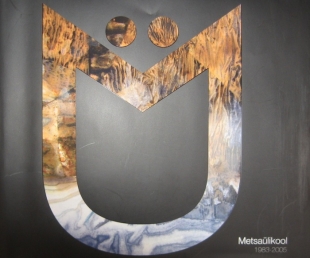By Eerik Purje and translated by Alja Pirosok
Metsaülikool (Forest University) 1983-2005. Edited by Tiina Kirss. Kotkajärve (Eagle Lake) Metsaülikool (Forest University), Canada, 2012. 506 p.
The last two thirds of the title are lifted from Arvo Valton, who surely will not mind. I did not think of the first third either, the metaphor simply got planted. It needs unpacking, but first let us examine the publication itself.
The new release in question is an album. I was going to say “commemorative album”, but I realized how out of place that expression is and gave myself a call-to-order rap on the knuckles. The deceased are ‘commemorated’, the living are ‘remembered’. Incredible, how it is possible to wrest concepts with just one cabbage-cutter-steel-edge-curved sizzling sound (mälestama vs. mäletama). Gathered between the covers of this album are 22 years of Estonianness in the best sense of the word. Estonianness, for which precisely wildness (metsikus) gives the right content and value. Where for an auditorium there’s a moss-covered slope of rock or a barracks house clapped together out of wooden boards; where lecturers and students are from the first moment on familiar “you” (sina) terms, participate as equals in common interest groups and delight in the joys of sauna side by side in the piercing steam-heat; where marble columns are replaced by the trunks of age-old indigenous trees and where the feeling of safeguarding is given by the stillness and peace of old-growth forest – there is the place, where a particular academic breath hovers, where divine balance gets continually recollected. The immediate contact between human and nature gets them conversing in a common language.
The album is as albums are – large format and voluminous, lots of first-class photos interspersed with comprehensive articles from “savages” (metslased) from every possible walk of life. A pleasure to browse through and admire, but at the same time it offers substantial reading, that provokes one to go on thinking. I would not recommend anyone start leafing through this at a social gathering, the text contains within itself too much infectious spirit. The album is divided into five parts, though the formation is not especially strict. Nor could it be, since there is much overlap in the subject areas.
The first part deals with creative Estonianness, followed by culture and its story. Metsaülikool’s love-child, Pocono Seminar 1976 in the Pennsylvania mountains after Baltimore ESTO, stands firmly on its own feet as a separate chapter. I apologize for the want of total piety, but I cannot find a more suitable term for this pleasant escapade. Even the photos are not resigned to peering out from the articles, but demand many pages of satellite status for themselves. A bundle of remembrances and reflections and then come the epoch-making years, that brought independence to our homeland. As a natural link follow MÜ’s metamorphoses, global MÜ and an A-B-C primer on learning to be Estonian. Finally speeches in honour of deceased lecturers – the gates of Toonela (the land of the dead) cannot be shut even by Kotkajärve’s idyllic milieu.
Tiina Kirss as editor was far from alone in doing this comprehensive work. She had a number of fine assistants, who receive their tributes on the overleaf of the title page. With the reader’s kind permission I will refrain from mentioning them here, not out of disrespect, but due to the fact that the listing of names has always robbed me of a part of the pleasure of writing. I would like to fully enjoy the latter in this piece. I have to make an exception of chief designer Marcus Kolga, whose design professionalism is awe-inspiring.
Oh yes, that mortar-full! Younger readers perhaps may not even know about this object that was a necessity of life for our ancestors. It was a dish hollowed out from a block of wood, into which was poured a crop, that was pounded fine with a pestle. It is just this vessel that both Metsaülikool (Forest University) and the album under consideration bring to this writer’s mind. Into it are poured together randomly and indiscriminately all the many facets of wild Estonianness. But there is no need for a pestle. Steeped in good will and honest endeavour half-ripe ideas blend and they crystallize, until the spores of pure, cultivated Estonianness spring up from them. That is just what we need.

